![A transport of Jewish prisoners marches through the snow from the Bauschovitz train station to Theresienstadt. [LCID: 69720]](https://encyclopedia.ushmm.org/images/large/781755a6-1ba5-4d8e-8b2b-9f25bdf3687f.jpg)
Browse an alphabetical list of film clips that feature important events before, during, and after the Holocaust and World War II. These clips include home movies, propaganda films, newsreels, and more.
<< Previous | Displaying results 1-12 of 12 for "Film" | Next >>
The film "Nazi Concentration Camps" was presented in the courtroom on November 29, 1945, and entered as evidence in the trial. It was filmed as Allied troops liberated the concentration camps. This clip shows the reactions of defendants and others in the courtroom following the screening of the film.
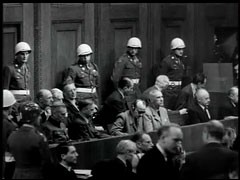
In July 1947, 4,500 Jewish refugees left displaced persons camps in Germany and boarded the "Exodus 1947" in France. They attempted to sail to Palestine although they did not have permission from British authorities to land. The British intercepted the ship and forcibly returned the Jewish refugees to Germany. Here, Jews from the "Exodus 1947" are confined in Poppendorf, Germany. The plight of the "Exodus" passengers became a symbol of the struggle for open Jewish emigration to Palestine.
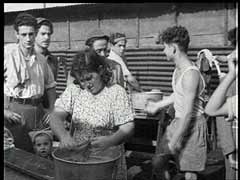
This footage shows the Reichstag (German parliament) building on the day after it was set on fire. While the origins of the fire on February 27 are still unclear, Hitler blamed Communists for the incident. The Reichstag Fire Decree of February 28, 1933, suspended constitutional guarantees. Communist and Socialist deputies were expelled from the parliament. Shortly after the decree was issued, the Nazis established concentration camps for the internment of political opponents.
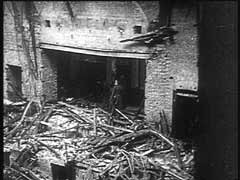
On the night of February 27, 1933, an unemployed Dutch construction worker named Marinus van der Lubbe set fire to the Reichstag (German parliament) building, causing serious damage. The Nazis blamed the Communists for the fire and claimed emergency powers to crush all opposition. Bolstering Nazi claims, the police also arrested three Bulgarian members of the Communist International, who were in Germany at the time, and a leading German Communist. Despite Nazi claims, however, responsibility for the fire…
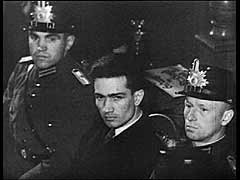
German forces launched Operation "Barbarossa," the invasion of the Soviet Union, on June 22, 1941. The German army made rapid initial progress in the campaign into Soviet territory. In this German military footage, German soldiers separate women and children from men in a Soviet village.
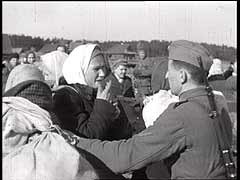
Provisions of the 1919 Treaty of Versailles forbade Germany (defeated in World War I) to station armed forces in a demilitarized zone in the Rhineland—a region in western Germany bordering France, Belgium, and part of the Netherlands. The treaty stipulated that Allied forces—including US troops—would occupy the region. In a blatant violation of the treaty, on March 7, 1936, Hitler ordered German troops to reoccupy the zone. Hitler gambled that the western powers would not intervene. His action…
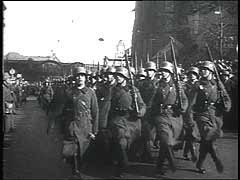
In June 1944, the Soviet Union launched a massive offensive against the German army in eastern Europe. Soviet forces reoccupied Vilna in July 1944, after bitter street fighting with the German garrison. They then continued on toward Kovno, the capital of Lithuania. This Soviet footage depicts the battle for Vilna and the final reoccupation of the city by the Soviet army.
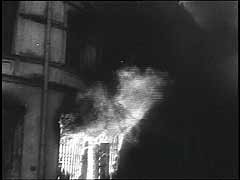
About a million Roma (Gypsies) lived in Europe before World War II. The largest Romani community—of about 300,000—was in Romania. This film shows a Romani (Gypsy) community in Moreni, a small town northwest of Bucharest. Many Roma led a nomadic lifestyle and often worked as small traders, craftsmen, merchants, laborers, and muscians.

Germany and its Axis allies invaded Yugoslavia in April 1941. The Germans probably shot this film after they occupied southern Slovenia following the Italian armistice in 1943. The film was found in the Ustasa (Croatian fascist) archives after World War II and shows the dismal living conditions that Roma (Gypsies) endured in occupied northern Yugoslavia.

This film excerpt from Groß-Stadt Zigeuner (1932) by filmmaker László Moholy-Nagy shows a Romani (Gypsy) campsite near Berlin, Germany, in the last year of the Weimar Republic. Although Roma (Gypsies) had faced persecution in Germany even before the Nazi rise to power in 1933, the Nazis regarded them as racial enemies to be identified and killed. Tens of thousands of Roma were killed by the Einsatzgruppen in eastern Europe or were deported to killing centers in occupied Poland.
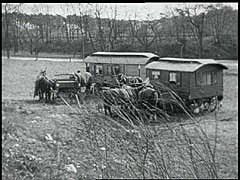
Eva Justin was an assistant to Dr. Robert Ritter, the Third Reich's "expert" on Roma (Gypsies). She studied these Romani (Gypsy) children as part of her dissertation on the racial characteristics of Roma. The children stayed at St. Josefspflege, a Catholic children's home in Mulfingen, Germany. Justin completed her study shortly after this film was taken. The children were deported to Auschwitz-Birkenau, where most were killed.
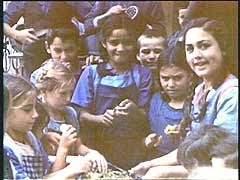
Although constrained by powerful isolationist sentiment in the United States, President Roosevelt was determined to help democratic Great Britain continue the war against Nazi Germany. Even as he promised to keep the United States neutral in the European war, Roosevelt ordered the expansion of military construction and pledged--as shown in this footage--that the United States would serve as the "great arsenal of democracy." In March 1941, Congress approved Lend-Lease aid for Britain. Britain ultimately…
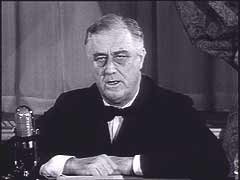
We would like to thank Crown Family Philanthropies, Abe and Ida Cooper Foundation, the Claims Conference, EVZ, and BMF for supporting the ongoing work to create content and resources for the Holocaust Encyclopedia. View the list of donor acknowledgement.